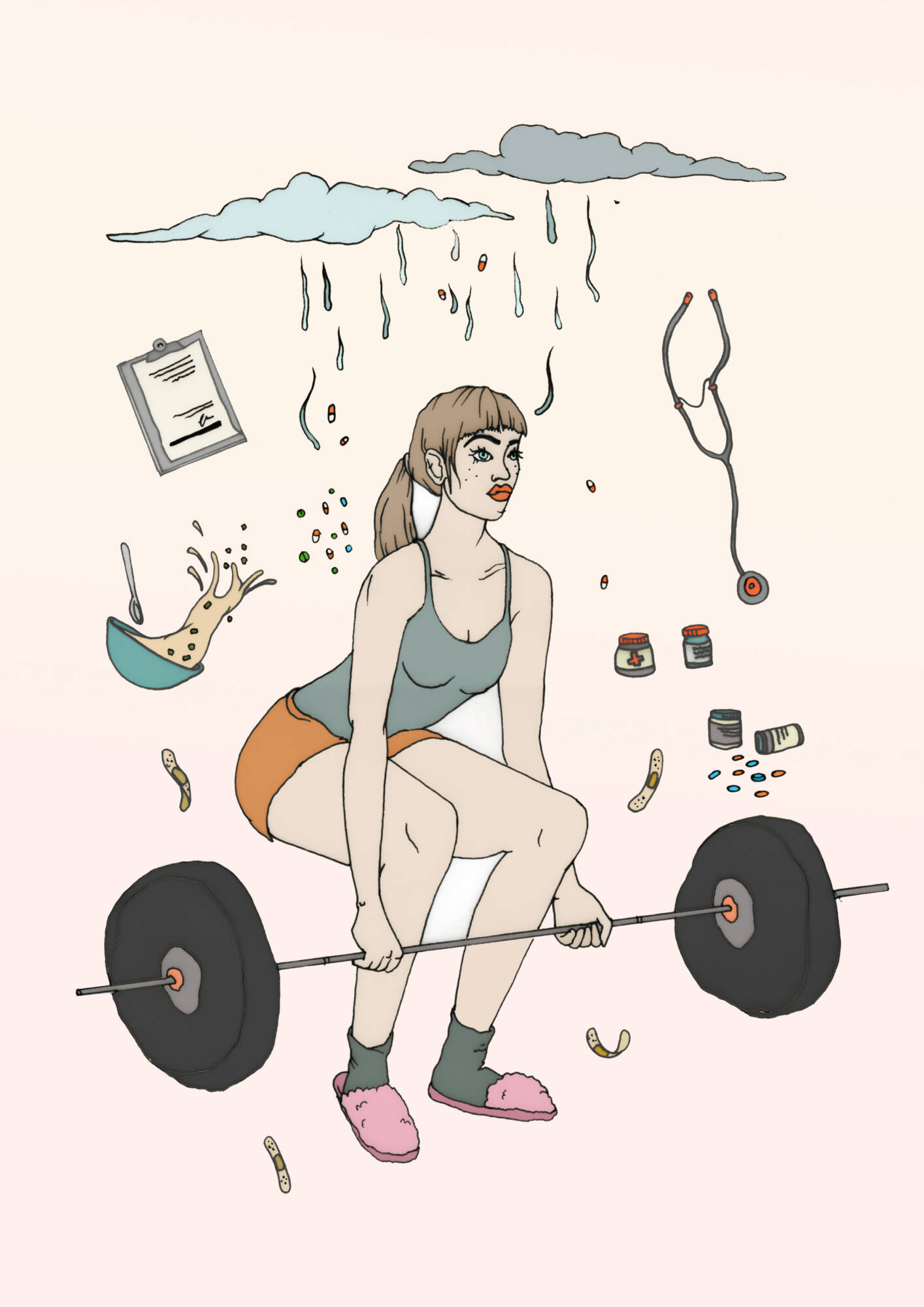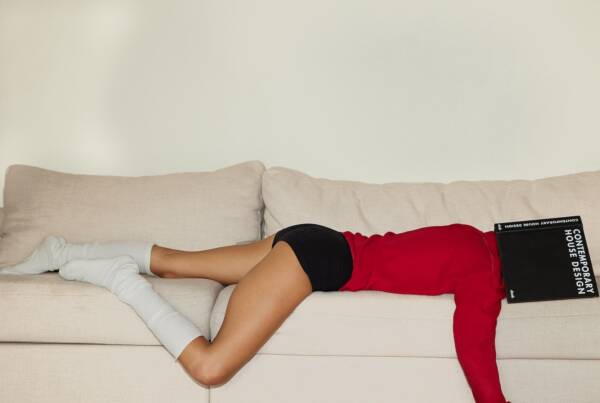Writing by Sophie Pellegrini // Illustration by Billie Morris // Weightlifting is one more way I get to defy the patriarchy as I build muscle, growing stronger and bigger, resisting the voices in my head and all around me that say I would be worth more if there were less of me.
Writing by Sophie Pellegrini // Illustration by Billie Morris

At the end of last year, I was sick, depressed, and completely disempowered in my body, due to a recently developed chronic illness. Exercise was an important means of managing my symptoms, but I didn’t know what else to do other than spend an hour a day plodding away bored on the treadmill or elliptical, developing shin splints and knee pain. I was a competitive swimmer until college, but when I gave up swimming, my commitment to and interest in exercise had disappeared with it. Growing up, I had always been someone who had taken her naturally slender form and fast metabolism (and the societal privileges that come with those things) for granted. But weight gain was a side effect of my illness (and the lack of exercise hadn’t helped), and I was upset as I watched my body changing into something I didn’t recognize. I had two new motivations to exercise: an unhealthy desire to change my body’s appearance, and a resentful need to feel better in the face of my illness—but neither one was sustainable. I got no joy or pleasure from exercise, and something had to change. At a loss, I finally contacted a personal trainer to help me re-vamp my fitness routine.
I was initially apprehensive when he suggested weightlifting. My intention had been to learn boxing, which I had always been curious about—I wasn’t really interested in weightlifting; I didn’t think I’d enjoy it, and I certainly didn’t think I was capable of lifting much more than some measly dumbbells. At first, it was a little weird and intimidating, the way learning a new skill often is. I felt particularly out of place as a woman in what I had always understood to be a male space. 10 times out of 10, there were more men weightlifting around me than women and femmes. 5 times out of 10, I was the only femme person in the free weights area at all.
But things slowly began to feel less awkward. I started to find a sense of meditation in the total internal focus weightlifting requires. I don’t mindlessly zone out or anxiously ruminate and obsess over my current life problems the way I do on a treadmill. I have to be completely present within my body to meet the resistance of the weights; I focus entirely on breathing through the movements and counting the reps.
It wasn’t long before I began to relish how concretely I could see and feel my progress, both during the workout and the days after, when muscle soreness served as a quiet, constant reminder of my effort. Even small increases in my reps or the weight I was lifting felt like an accomplishment. Progress is slow and steady, but watching my body adapt to the challenges I present it with is still amazing to me a year later. Each time I lift, I’m working to redevelop respect for my body and all the amazing things it does every second of every day to keep me alive and as healthy as possible. My focus continues to shift from what my body looks like to what my body can do and how exercise makes me feel.
After spending months preoccupied with all I felt my body couldn’t do, weightlifting not only helped me shift my perspective on my body’s capabilities, but also on failure. Failure in weightlifting is, in an odd sense, the goal. When I started, I was embarrassed when I failed to complete a rep. My muscles would give out during a bench press and my trainer had to take an active role as spotter, lifting the bar for me so it didn’t fall onto my chest or face. Sometimes when I squat a new weight, my legs literally can’t push me back up to standing—and I can’t think my way out of it or mentally pressure my body into something it can’t yet do, so I fall backwards onto my ass as the weighted bar bangs loudly against the safety bars. But that initial embarrassment I felt has been replaced with a sense of humility, intention, and motivation to try again. It’s only when I push my body to its limits and allow it to strengthen from that workout that I can ask it for more. Over time, I learned to hear and respect my body when it told me I had reached those limits, slowly reconnecting with its language. After the hardest, sickest year of my life; after months of feeling completely unable to control or connect with my body, it didn’t feel so foreign anymore.
During the first few months of lifting, I also felt the empowerment that comes with defying ideas about what women can’t and shouldn’t do with their bodies. When I step on to the deadlift platform, I often feel this cheesy sense of connectedness with all the people who have taken on the challenge of infiltrating a cis-male-dominated space. I like defying the skeptical gazes of the men who watch me rack weight onto the bar before I deadlift, or patronizingly offer to re-rack my plates after a set of squats (I politely and confidently turn them down). I used to ask permission—prefaced with an apology—before taking unused plates from another rack, until I realized that other guys took plates off of my rack, and each other’s, without asking first. I no longer let guilt prevent me from using a bench, afraid some “more worthy” guy may have to wait to use it. I feel no obligation to follow the unsolicited, unfounded advice random men offer me on my technique or form as a reflection of their need to mansplain, even if they stand there to watch if I take it. I fight through the anxiety I feel when I deny my instincts to wait and instead ask if I can work in while a man is using the platform.
This experience within weightlifting has made me think about the endless ways women are taught to question our right to space; how we’re socialized to shrink and contain ourselves and bend over backwards (but discretely, please) to avoid inconveniencing anyone—especially cis men. The way cis men comfortably take up space in ways that women don’t became even more apparent and impossible to ignore: legs spread wide on subways next to women who tightly fold their limbs; the consistent catcalling in public spaces; men that grind against women on the dance floor without consent. The examples of men dominating the physical, social, political, and intellectual spaces around them, often without awareness or ill intentions, are endless, as are the corresponding messages that teach women to doubt their right to those spaces. Even within weightlifting, the media’s message for women focuses on the need to lose weight, because being thin and small is best. The message is most often, “don’t worry girls, weightlifting won’t make you too bulky—and it’ll help you lose weight faster than cardio!!” While men are promised secrets of how to “get,” “gain,” and “build,” women are told to “lose,” “burn,” and “tone.”
I’d be lying if I said that weightlifting completely alleviated my body insecurities, but there’s no doubt that shifting my exercise to weight training and boxing instead of body-anxiety-producing cardio machines has made a crucial difference. Weightlifting reminds me that there’s real purpose to exercise irrespective of weight loss, and that my body is worthy of respect regardless of its size. It helps me defy what society has taught me to believe—that women’s bodies and appearances determine our worth, and that thin bodies are inherently best. It helps me become more comfortable with advocating for myself in male-dominated spaces. It’s one more way I get to challenge the patriarchy as I build muscle, growing stronger and bigger, resisting the voices in my head and all around me that say I would be worth more if there were less of me.
I’m incredibly privileged and extremely grateful for the opportunities I have. Not everyone has the luxury of joining a gym, let alone paying for a personal trainer, and I’m exempt from a whole range of limitations (in the realms of exercise and beyond) due to my white skin, the fact that I’m cis, and my body size and ability. But I believe there are endless ways women can start to take up space, whether it’s trying weightlifting, fighting the urge to automatically cross our legs on buses without question, or speaking up in class without starting every question we ask with an apology. And those of us with privilege have a responsibility to help open the space to be filled by other marginalized voices, ahead of our own. Women have amazing things to do and give and say. And it’s time to take up more space.






